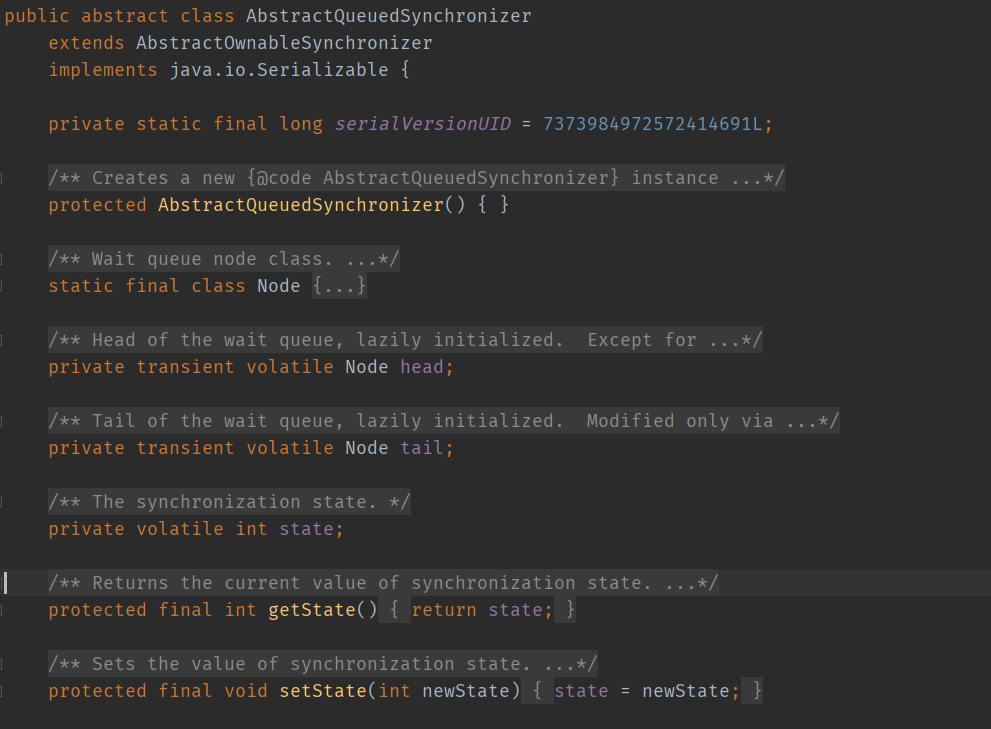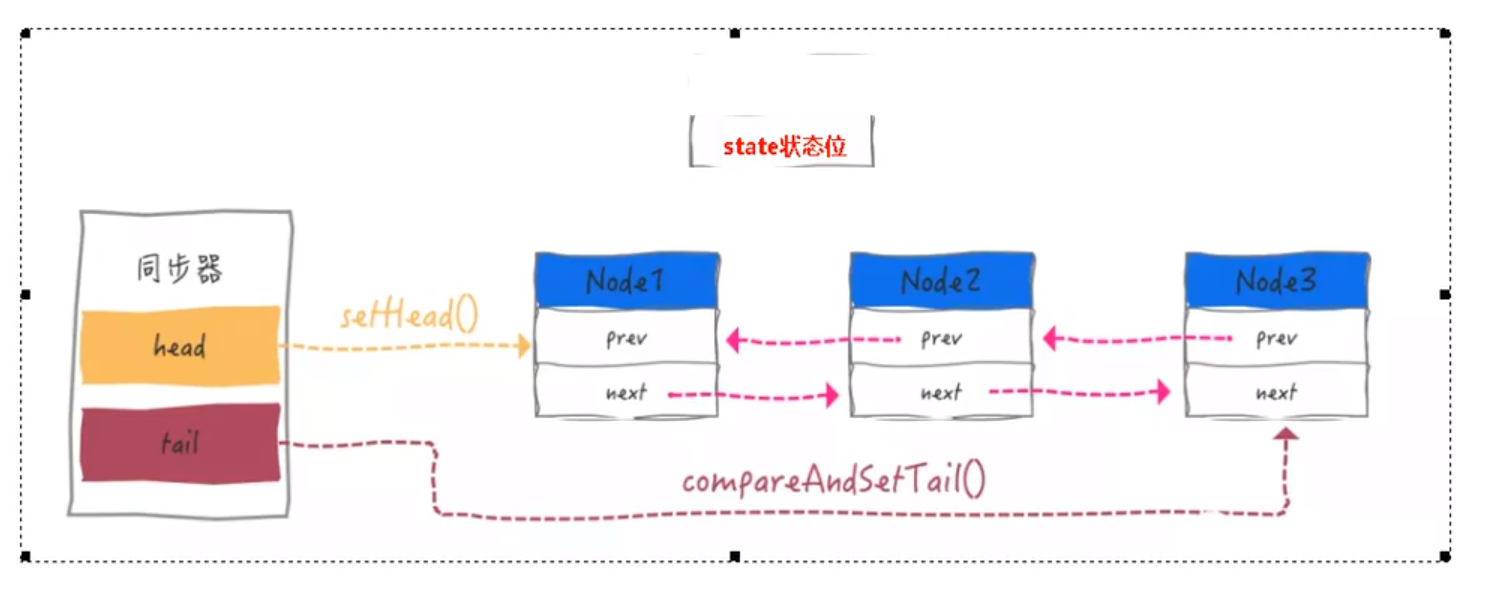жӮЁеҘҪпјҢзҷ»еҪ•еҗҺжүҚиғҪдёӢи®ўеҚ•е“ҰпјҒ
жӮЁеҘҪпјҢзҷ»еҪ•еҗҺжүҚиғҪдёӢи®ўеҚ•е“ҰпјҒ
жң¬зҜҮеҶ…е®№д»Ӣз»ҚдәҶвҖңеҰӮдҪ•зҗҶи§ЈAQSжәҗз ҒвҖқзҡ„жңүе…ізҹҘиҜҶпјҢеңЁе®һйҷ…жЎҲдҫӢзҡ„ж“ҚдҪңиҝҮзЁӢдёӯпјҢдёҚе°‘дәәйғҪдјҡйҒҮеҲ°иҝҷж ·зҡ„еӣ°еўғпјҢжҺҘдёӢжқҘе°ұи®©е°Ҹзј–еёҰйўҶеӨ§е®¶еӯҰд№ дёҖдёӢеҰӮдҪ•еӨ„зҗҶиҝҷдәӣжғ…еҶөеҗ§пјҒеёҢжңӣеӨ§е®¶д»”з»Ҷйҳ…иҜ»пјҢиғҪеӨҹеӯҰжңүжүҖжҲҗпјҒ
AQS abstractQueueSynchronizerпјҲжҠҪиұЎйҳҹеҲ—еҗҢжӯҘеҷЁпјүпјҢжҳҜд»Җд№Ҳпјҹ
зӯ”пјҡе®ғжҳҜз”ЁжқҘжһ„е»әй”Ғ жҲ–иҖ… е…¶д»–еҗҢжӯҘеҷЁз»„件зҡ„йҮҚйҮҸзә§еҹәзЎҖжЎҶжһ¶пјҢжҳҜж•ҙдёӘJUCдҪ“зі»зҡ„еҹәзЎҖгҖӮйҖҡиҝҮеҶ…зҪ®FIFOйҳҹеҲ—жқҘе®ҢжҲҗиҺ·еҸ–зәҝзЁӢеҸ–й”Ғзҡ„жҺ’йҳҹе·ҘдҪңпјҢ并йҖҡиҝҮдёҖдёӘintзұ»еһӢеҸҳйҮҸж ҮиҜҶжҢҒжңүй”Ғзҡ„зҠ¶жҖҒпјӣ
еүҚзҪ®зҹҘиҜҶзӮ№пјҡ
1гҖҒеҸҜйҮҚе…Ҙй”ҒпјҲйҖ’еҪ’й”Ғпјүпјҡ
syncпјҲйҡҗејҸй”ҒпјҢjvmз®ЎзҗҶпјүе’ҢReentrantLockпјҲLockжҳҫејҸй”ҒпјҢе°ұжҳҜжүӢеҠЁеҠ и§ЈпјүжҳҜйҮҚе…Ҙй”Ғзҡ„е…ёеһӢд»ЈиЎЁпјҢдёәеҸҜд»ҘйҮҚеӨҚдҪҝз”Ёзҡ„й”ҒгҖӮдёҖдёӘеҸҳжҲҗеӨҡдёӘжөҒзЁӢпјҢеҸҜд»ҘиҺ·еҸ–еҗҢдёҖжҠҠй”ҒгҖӮ
еҸҜйҮҚе…Ҙй”ҒжҰӮеҝөпјҡ жҳҜжҢҮдёҖдёӘзәҝзЁӢпјҢеңЁеӨ–еұӮж–№жі•иҺ·еҸ–й”Ғзҡ„ж—¶еҖҷпјҢеҶҚж¬Ўиҝӣе…ҘиҜҘзәҝзЁӢзҡ„еҶ…еұӮж–№жі•дјҡиҮӘеҠЁиҺ·еҸ–й”ҒпјҲеҝ…йЎ»жҳҜеҗҢдёҖдёӘеҜ№иұЎпјүпјҢдёҚдјҡиў«йҳ»еЎһгҖӮеҸҜйҒҝе…Қжӯ»й”Ғ
дёҫдҫӢпјҡ йҖ’еҪ’и°ғз”ЁеҗҢдёҖдёӘ syncдҝ®йҘ°зҡ„ж–№жі•жҲ–иҖ…д»Јз Ғеқ—гҖӮеҝ…йЎ»жҳҜдёҖдёӘеҜ№иұЎжүҚиЎҢгҖӮдёҖдёӘзәҝзЁӢи°ғз”ЁдёҖдёӘеҜ№иұЎзҡ„method1,method1 и°ғз”Ёmethod2пјҢmethod2и°ғз”Ёmethod3, 3дёӘж–№жі•йғҪжҳҜиў«syncдҝ®йҘ°пјҢиҝҷж ·д№ҹжҳҜдёҖдёӘеҸҜйҮҚе…Ҙй”Ғзҡ„дҫӢеӯҗ гҖӮ
еҶҚжҜ”еҰӮдёӢйқўиҝҷз§Қ
static Object lock = new Object();
public void mm(){
synchronized (lock){
System.out.println("===========mm method");
synchronized (lock){
System.out.println("=========== method");
}
}
}еҸӘжңүдёҖдёӘеҜ№иұЎ е’ҢеҗҢжӯҘд»Јз Ғеқ—пјҢеҰӮжһңsycnдёӯеөҢеҘ—sync 并йғҪжҳҜlockеҜ№иұЎпјҢйӮЈд№ҲиҜҘзәҝзЁӢе°ұдјҡжҢҒжңүеҪ“еүҚеҜ№иұЎзҡ„й”ҒпјҢ并еҸҜйҮҚе…ҘгҖӮеҸҚзј–иҜ‘еҗҺеҸ‘зҺ°
public void mm(); Code: 0: getstatic #7 // Field lock:Ljava/lang/Object; 3: dup 4: astore_1 5: monitorenter 6: getstatic #8 // Field java/lang/System.out:Ljava/io/PrintStream; 9: ldc #9 // String ===========mm method 11: invokevirtual #10 // Method java/io/PrintStream.println:(Ljava/lang/String;)V 14: aload_1 15: monitorexit 16: goto 24 19: astore_2 20: aload_1 21: monitorexit 22: aload_2 23: athrow 24: return Exception table: from to target type 6 16 19 any 19 22 19 any
syncеҗҢжӯҘд»Јз Ғеқ—еҠ и§Јй”ҒпјҢдҪҝз”Ёзҡ„е‘Ҫд»Өдёәmonitorenter е’Ң monitorexitпјҲеҗҢжӯҘж–№жі•ж ҮиҜҶжҳҜACC_SYNCHRONIZEDпјҢеңЁflagдёӯпјү,enter дёәеҠ й”ҒпјҢеҝ…йЎ»жҲҗеҜ№еҮәзҺ°пјҢдҪҶиҝҷйҮҢеҚҙеҸҲдёӨдёӘexitгҖӮеҺҹеӣ дёә第дёҖдёӘexitдёәзЁӢеәҸжӯЈеёёиҝҗиЎҢеҗҺзҡ„и§Јй”Ғе‘Ҫд»ӨпјҢ并жү§иЎҢе®ҢеҗҺдјҡжү§иЎҢgotoеҲ°return пјҢд№ҹе°ұжҳҜ第24иЎҢпјҢ
第дәҢдёӘexit дёәеҪ“зЁӢеәҸеҮәзҺ°ејӮеёёж—¶пјҢйңҖиҰҒжү§иЎҢзҡ„и§Јй”Ғе‘Ҫд»Өпјӣ
еҰӮдёҠе°ұжҳҜеҸҜйҮҚе…Ҙй”Ғзҡ„зӣёе…іжҰӮеҝө
2гҖҒд»Җд№ҲжҳҜLockSupportпјҹ
ж №жҚ®jdk8 зҡ„apiж–ҮжЎЈжҳҫзӨәе®ҡд№үдёәпјҡ з”ЁдәҺеҲӣе»әй”Ғе’Ңе…¶д»–еҗҢжӯҘзұ»зҡ„еҹәжң¬зәҝзЁӢйҳ»еЎһеҺҹиҜӯпјӣ
жҳҜдёҖдёӘзәҝзЁӢйҳ»еЎһе·Ҙе…·зұ»пјҢжүҖжңүж–№жі•еқҮдёәйқҷжҖҒпјҢеҸҜд»Ҙи®©зәҝзЁӢеңЁд»»ж„ҸдҪҚзҪ®йҳ»еЎһпјҢйҳ»еЎһеҗҺд№ҹжңүеҜ№еә”зҡ„е”ӨйҶ’ж–№жі•гҖӮ
е…ҲеӨҚд№ дёӢobject еҜ№иұЎзҡ„wait е’Ң notify е’ҢLock зҡ„condition
wait е’Ңnotify еҝ…йЎ»еңЁsync д»Јз Ғеқ—дёӯжүҚиғҪдҪҝз”ЁпјҢеҗҰеҲҷжҠҘй”ҷгҖӮйқһжі•зҡ„зӣ‘и§ҶеҷЁ
conditionзҡ„await е’Ң signalж–№жі•д№ҹеҝ…йЎ»еңЁlock е’Ңunlockж–№жі•еүҚжү§иЎҢпјҢеҗҰеҲҷжҠҘй”ҷпјҢйқһжі•зҡ„зӣ‘и§ҶеҷЁ
зәҝзЁӢдёҖе®ҡиҰҒе…Ҳ зӯүеҫ… пјҢеҶҚ иў« е”ӨйҶ’пјҢйЎәеәҸдёҚиғҪжҚў
LockSupport жңүдёӨдёӘе…ій”®еҮҪж•° park е’ҢunparkпјҢиҜҘзұ»дҪҝз”ЁдәҶPermitпјҲи®ёеҸҜиҜҒпјүзҡ„жҰӮеҝөжқҘйҳ»еЎһе’Ңе”ӨйҶ’зәҝзЁӢзҡ„еҠҹиғҪгҖӮжҜҸдёӘзәҝзЁӢйғҪдјҡжңүдёҖдёӘPermitпјҢиҜҘPermit еҸӘжңүдёӨдёӘеҖј 0 е’Ң1 пјҢй»ҳи®ӨжҳҜ0гҖӮзұ»дјјдәҺдҝЎеҸ·йҮҸпјҢдҪҶдёҠйҷҗжҳҜ1пјӣ
жқҘзңӢparkж–№жі•пјҡ
public static void park() {
//unsafeзҡ„ж–№жі•гҖӮеҲқе§Ӣдёә0
UNSAFE.park(false, 0L);
}зҰҒжӯўеҪ“еүҚзәҝзЁӢиҝӣиЎҢзәҝзЁӢи°ғеәҰпјҢйҷӨйқһPermitеҸҜз”ЁпјҢе°ұжҳҜ1
еҰӮжһңPermit дёә1пјҲжңүеҸҜз”ЁиҜҒд№Ұпјү е°ҶеҸҳжӣҙдёә0пјҲзәҝзЁӢд»Қ然дјҡеӨ„зҗҶдёҡеҠЎйҖ»иҫ‘пјүпјҢ并且з«ӢеҚіиҝ”еӣһгҖӮеҗҰеҲҷеҪ“еүҚзәҝзЁӢеҜ№дәҺзәҝзЁӢи°ғеәҰзӣ®зҡ„е°Ҷиў«зҰҒз”ЁпјҢ并еӨ„дәҺдј‘зң зҠ¶жҖҒгҖӮзӣҙиҮіеҸ‘з”ҹдёү件дәӢжғ…д№ӢдёҖпјҡ
дёҖдәӣе…¶д»–зәҝзЁӢи°ғз”ЁеҪ“еүҚзәҝзЁӢдҪңдёәзӣ®ж Үзҡ„unpark ; иҰҒд№Ҳ
е…¶д»–дёҖдәӣзәҝзЁӢеҪ“еүҚзәҝзЁӢдёәinterrupts ; иҰҒд№Ҳ
з”өиҜқиҷҡеҒҮпјҲд№ҹе°ұжҳҜиҜҙпјҢжІЎжңүзҗҶз”ұпјүиҝ”еӣһгҖӮ
иҝҷз§Қж–№жі•дёҚжҠҘе‘ҠжҳҜе“ӘдёӘзәҝзЁӢеҜјиҮҙиҜҘж–№жі•иҝ”еӣһгҖӮ жқҘз”өиҖ…еә”йҮҚж–°жЈҖжҹҘеҜјиҮҙзәҝзЁӢйҰ–е…ҲеҒңж”ҫзҡ„жқЎд»¶гҖӮ е‘јеҸ«иҖ…иҝҳеҸҜд»ҘзЎ®е®ҡзәҝзЁӢеңЁиҝ”еӣһж—¶зҡ„дёӯж–ӯзҠ¶жҖҒгҖӮ
е°Ҹз»“пјҡPermitй»ҳи®Ө0пјҢжүҖд»ҘдёҖејҖе§Ӣи°ғз”ЁparkпјҢеҪ“еүҚзәҝзЁӢиў«йҳ»еЎһпјҢзӣҙеҲ°еҲ«зҡ„зәҝзЁӢе°ҶеҪ“еүҚзәҝзЁӢзҡ„Permitдҝ®ж”№дёә1пјҢд»Һparkж–№жі•еӨ„иў«е”ӨйҶ’пјҢеӨ„зҗҶдёҡеҠЎпјҢ然еҗҺдјҡе°Ҷpermitдҝ®ж”№дёә0пјҢ并иҝ”еӣһпјӣеҰӮжһңpermitдёә1пјҢи°ғз”Ёparkж—¶дјҡе°Ҷpermitдҝ®ж”№дёә0пјҢеңЁжү§иЎҢдёҡеҠЎйҖ»иҫ‘еҲ°зәҝзЁӢз”ҹе‘Ҫе‘ЁжңҹгҖӮдёҺparkж–№жі•е®ҡд№үеҗ»еҗҲгҖӮ
еңЁзңӢunparkж–№жі•пјҡ
public static void unpark(Thread thread) {
if (thread != null)
UNSAFE.unpark(thread);
}еңЁи°ғз”Ёunparkж–№жі•еҗҺпјҢдјҡе°ҶThreadзәҝзЁӢзҡ„и®ёеҸҜpermitи®ҫзҪ®жҲҗ1пјҢдјҡиҮӘеҠЁе”ӨйҶ’threadзәҝзЁӢпјҢеҚіпјҢд№ӢеүҚйҳ»еЎһдёӯзҡ„LockSupport.parkж–№жі•дјҡз«ӢеҚіиҝ”еӣһпјҢ然еҗҺзәҝзЁӢжү§иЎҢдёҡеҠЎйҖ»иҫ‘ гҖӮ дё” unparkеҸҜд»ҘеңЁparkд№ӢеүҚжү§иЎҢгҖӮзӣёеҪ“дәҺжү§иЎҢparkжІЎжңүж•ҲжһңгҖӮ
3гҖҒAQS abstractQueueSynchronizer жәҗз Ғ
еү©дҪҷеүҚзҪ®зҹҘиҜҶдёәпјҡ е…¬е№ій”ҒгҖҒйқһе…¬е№ій”ҒгҖҒиҮӘж—Ӣй”ҒгҖҒй“ҫиЎЁгҖҒжЁЎжқҝи®ҫи®ЎжЁЎејҸ
AQSдҪҝз”Ёvolatileдҝ®йҘ°зҡ„intзұ»еһӢзҡ„еҸҳйҮҸ ж ҮиҜҶй”Ғзҡ„зҠ¶жҖҒпјҢйҖҡиҝҮеҶ…зҪ®зҡ„FIFOйҳҹеҲ—жқҘе®ҢжҲҗиө„жәҗиҺ·еҸ–зҡ„жҺ’йҳҹе·ҘдҪңпјҢе°ҶжҜҸжқЎиҰҒеҺ»жҠўеҚ иө„жәҗзҡ„зәҝзЁӢе°ҒиЈ…жҲҗnodeиҠӮзӮ№е®һзҺ°й”Ғзҡ„еҲҶй…ҚпјҢйҖҡиҝҮCASпјҲиҮӘж—Ӣй”Ғпјүе®ҢжҲҗеҜ№stateеҖјзҡ„дҝ®ж”№ пјӣ

пјҲ1пјүnodeиҠӮзӮ№жәҗз Ғ
static final class Node {
/** Marker to indicate a node is waiting in shared mode */
//е…ұдә«иҠӮзӮ№
static final Node SHARED = new Node();
/** Marker to indicate a node is waiting in exclusive mode */
//зӢ¬еҚ иҠӮзӮ№
static final Node EXCLUSIVE = null;
/** waitStatus value to indicate thread has cancelled */
//зәҝзЁӢиў«еҸ–ж¶ҲзҠ¶жҖҒ
static final int CANCELLED = 1;
/** waitStatus value to indicate successor's thread needs unparking */
// еҗҺз»ӯзәҝзЁӢйңҖиҰҒе”ӨйҶ’
static final int SIGNAL = -1;
/** waitStatus value to indicate thread is waiting on condition */
//йӮ“дё№conditionе”ӨйҶ’
static final int CONDITION = -2;
/**
* waitStatus value to indicate the next acquireShared should
* unconditionally propagate
*/
//е…ұдә«е®ӨеҗҢжӯҘзҠ¶жҖҒиҺ·еҸ– е°Ҷдјҡж— жқЎд»¶дј ж’ӯдёӢеҺ»
static final int PROPAGATE = -3;
/**
* Status field, taking on only the values:
* SIGNAL: The successor of this node is (or will soon be)
* blocked (via park), so the current node must
* unpark its successor when it releases or
* cancels. To avoid races, acquire methods must
* first indicate they need a signal,
* then retry the atomic acquire, and then,
* on failure, block.
* CANCELLED: This node is cancelled due to timeout or interrupt.
* Nodes never leave this state. In particular,
* a thread with cancelled node never again blocks.
* CONDITION: This node is currently on a condition queue.
* It will not be used as a sync queue node
* until transferred, at which time the status
* will be set to 0. (Use of this value here has
* nothing to do with the other uses of the
* field, but simplifies mechanics.)
* PROPAGATE: A releaseShared should be propagated to other
* nodes. This is set (for head node only) in
* doReleaseShared to ensure propagation
* continues, even if other operations have
* since intervened.
* 0: None of the above
*
* The values are arranged numerically to simplify use.
* Non-negative values mean that a node doesn't need to
* signal. So, most code doesn't need to check for particular
* values, just for sign.
*
* The field is initialized to 0 for normal sync nodes, and
* CONDITION for condition nodes. It is modified using CAS
* (or when possible, unconditional volatile writes).
*/
//еҲқе§Ӣдёә0пјҢзҠ¶жҖҒжҳҜдёҠйқўеҮ з§ҚпјҢж ҮиҜҶеҪ“еүҚиҠӮзӮ№еңЁйҳҹеҲ—дёӯзҡ„зҠ¶жҖҒ
volatile int waitStatus;
/**
* Link to predecessor node that current node/thread relies on
* for checking waitStatus. Assigned during enqueuing, and nulled
* out (for sake of GC) only upon dequeuing. Also, upon
* cancellation of a predecessor, we short-circuit while
* finding a non-cancelled one, which will always exist
* because the head node is never cancelled: A node becomes
* head only as a result of successful acquire. A
* cancelled thread never succeeds in acquiring, and a thread only
* cancels itself, not any other node.
*/
//еүҚзҪ®иҠӮзӮ№
volatile Node prev;
/**
* Link to the successor node that the current node/thread
* unparks upon release. Assigned during enqueuing, adjusted
* when bypassing cancelled predecessors, and nulled out (for
* sake of GC) when dequeued. The enq operation does not
* assign next field of a predecessor until after attachment,
* so seeing a null next field does not necessarily mean that
* node is at end of queue. However, if a next field appears
* to be null, we can scan prev's from the tail to
* double-check. The next field of cancelled nodes is set to
* point to the node itself instead of null, to make life
* easier for isOnSyncQueue.
*/
//еҗҺзҪ®иҠӮзӮ№
volatile Node next;
/**
* The thread that enqueued this node. Initialized on
* construction and nulled out after use.
*/
//еҪ“зәҝзЁӢеҜ№иұЎ
volatile Thread thread;
/**
* Link to next node waiting on condition, or the special
* value SHARED. Because condition queues are accessed only
* when holding in exclusive mode, we just need a simple
* linked queue to hold nodes while they are waiting on
* conditions. They are then transferred to the queue to
* re-acquire. And because conditions can only be exclusive,
* we save a field by using special value to indicate shared
* mode.
*/
Node nextWaiter;
/**
* Returns true if node is waiting in shared mode.
*/
final boolean isShared() {
return nextWaiter == SHARED;
}
/**
* Returns previous node, or throws NullPointerException if null.
* Use when predecessor cannot be null. The null check could
* be elided, but is present to help the VM.
*
* @return the predecessor of this node
*/
final Node predecessor() throws NullPointerException {
Node p = prev;
if (p == null)
throw new NullPointerException();
else
return p;
}nodeиҠӮзӮ№е°ұжҳҜжҜҸдёҖдёӘзӯүеҫ…жү§иЎҢзҡ„зәҝзЁӢгҖӮиҝҳжңүдёҖдёӘwaitStateзҠ¶жҖҒеӯ—ж®өпјҢж ҮиҜҶеҪ“еүҚзӯүеҫ…дёӯзҡ„зәҝзЁӢзҠ¶жҖҒ
ж №жҚ®nodeиҠӮзӮ№ з»ҳз”»дёҖдёӘaqsеҹәжң¬з»“жһ„еӣҫ

и§ЈйҮҠпјҡstateдёәзҠ¶жҖҒдҪҚпјҢaqsдёәеҗҢжӯҘеҷЁгҖӮжңүhead е’ҢtailдёӨдёӘ еӨҙ е°ҫиҠӮзӮ№пјҢеҪ“state = 1ж—¶пјҢиЎЁжҳҺеҗҢжӯҘеҷЁиў«еҚ з”ЁпјҲжҲ–иҖ…иҜҙеҪ“еүҚжңүзәҝзЁӢжҢҒжңүдәҶеҗҢдёҖдёӘеҜ№иұЎзҡ„й”ҒпјүпјҢе°ҶеҗҺз»ӯзәҝзЁӢж·»еҠ еҲ°йҳҹеҲ—дёӯпјҢ并用еҸҢеҗ‘й“ҫиЎЁиҝһжҺҘпјҢйҒөеҫӘFIFOгҖӮ
пјҲ2пјүд»ҘReentrantLockзҡ„е®һзҺ°еҲҶжһҗгҖӮеӣ дёәд»–д№ҹе®һзҺ°дәҶLock 并еҶ…йғЁжҢҒжңүеҗҢжӯҘеҷЁsyncе’ҢAQSпјҲд»Ҙ银иЎҢжҹңеҸ°дҫӢеӯҗпјү
new ReentrantLockпјҲпјүжҲ– new ReentrantLock(false)ж—¶пјҢеҲӣе»әзҡ„жҳҜйқһе…¬е№ій”Ғ,иҖҢ ReentrantLockеҜ№иұЎеҶ…йғЁиҝҳжңү дёӨдёӘзұ» еҲҶеҲ«дёәе…¬е№іеҗҢжӯҘеҷЁе’Ңйқһе…¬е№іеҗҢжӯҘеҷЁ
static final class NonfairSync extends Sync //е…¬е№ій”Ғ жңүдёҖдёӘеҲӨж–ӯйҳҹеҲ—дёӯжҳҜеҗҰжңүжҺ’йҳҹзҡ„зәҝзЁӢпјҢиҝҷжҳҜдёҺдёҠйқўй”ҒдёҚеҗҢзҡ„иҺ·еҸ–ж–№ејҸ static final class FairSync extends Sync
е…¬е№ій”Ғи§ЈйҮҠпјҡе…ҲеҲ°е…Ҳеҫ—пјҢж–°зәҝзЁӢеңЁиҺ·еҸ–й”Ғж—¶пјҢеҰӮжһңиҝҷдёӘеҗҢжӯҘеҷЁзҡ„зӯүеҫ…йҳҹеҲ—дёӯе·Із»ҸжңүзәҝзЁӢеңЁзӯүеҫ…пјҢйӮЈд№ҲеҪ“еүҚзәҝзЁӢдјҡе…Ҳиҝӣе…Ҙзӯүеҫ…йҳҹеҲ—пјӣ
йқһе…¬е№ій”Ғи§ЈйҮҠпјҡж–°иҝӣжқҘзҡ„зәҝзЁӢдёҚз®ЎжҳҜеҗҰжңүзӯүеҫ…зҡ„зәҝзЁӢпјҢеҰӮжһңеҸҜд»ҘиҺ·еҸ–й”ҒпјҢеҲҷз«ӢеҲ»еҚ жңүй”ҒгҖӮ
иҝҷйҮҢиҝҳжңүдёҖдёӘе…ій”®зҡ„жЁЎжқҝи®ҫи®ЎжЁЎејҸпјҡ еңЁжҹҘиҜўaqsзҡ„tryAcquireж–№жі•ж—¶еҸ‘зҺ°пјҢиҜҘж–№жі•зӣҙжҺҘжҠӣеҮәејӮеёёпјҢиҝҷе°ұжҳҜе…ёеһӢзҡ„жЁЎжқҝи®ҫи®ЎжЁЎејҸпјҢејәеҲ¶иҰҒжұӮеӯҗзұ»йҮҚеҶҷиҜҘж–№жі•гҖӮеҗҰеҲҷдёҚи®©з”Ё
1.1 еҪ“зәҝзЁӢaеҲ°жҹңеҸ°еҠһзҗҶдёҡеҠЎж—¶пјҢдјҡи°ғз”Ёsync зҡ„lockпјҢеҚі aзәҝзЁӢи°ғз”Ёlockж–№жі•
final void lock() {
//еҲ©з”Ёcasе°ҶеҪ“еүҚеҜ№иұЎзҡ„state д»Һ0 и®ҫзҪ®жҲҗ1пјҢеҪ“然йҮҢйқўиҝҳжңүдёҖдёӘеҒҸ移йҮҸ
//ж„ҸжҖқе°ұжҳҜеҰӮжһңжҳҜ0 е°ұи®ҫзҪ®дёә1жҲҗеҠҹиҝ”еӣһtrue
if (compareAndSetState(0, 1))
setExclusiveOwnerThread(Thread.currentThread());
else
acquire(1);
}еӣ дёәжҳҜ第дёҖдёӘиҝҗиЎҢзҡ„зәҝзЁӢпјҢиӮҜе®ҡжҳҜtrueжүҖд»ҘпјҢе°ҶеҪ“еүҚиҝҗиЎҢзҡ„зәҝзЁӢи®ҫзҪ®дёәaпјҢеҚіaзәҝзЁӢеҚ з”ЁдәҶеҗҢжӯҘеҷЁпјҢиҺ·еҸ–дәҶй”Ғ
1.2 еҪ“bзәҝзЁӢиҝҗиЎҢlockж—¶пјҢеҸ‘зҺ°дёҚиғҪе°Ҷ0и®ҫзҪ®жҲҗ1пјҲcasжҖқжғіпјүпјҢе°ұдјҡиҝҗиЎҢacquireпјҲ1пјүж–№жі•
public final void acquire(int arg) {
//иҝҷйҮҢз”ЁеҲ°дәҶжЁЎжқҝи®ҫи®ЎжЁЎејҸпјҢејәеҲ¶еӯҗзұ»е®һзҺ°иҜҘж–№жі•
//еӣ дёәй»ҳи®ӨдҪҝз”Ёйқһе…¬е№ій”ҒпјҢжүҖд»ҘзңӢNonfairSync
if (!tryAcquire(arg) &&
acquireQueued(addWaiter(Node.EXCLUSIVE), arg))
selfInterrupt();
}
static final class NonfairSync extends Sync {
private static final long serialVersionUID = 7316153563782823691L;
/**
* Performs lock. Try immediate barge, backing up to normal
* acquire on failure.
*/
final void lock() {
if (compareAndSetState(0, 1))
setExclusiveOwnerThread(Thread.currentThread());
else
acquire(1);
}
protected final boolean tryAcquire(int acquires) {
return nonfairTryAcquire(acquires);
}
}
//иҜҘж–№жі•е°ұжҳҜйқһе…¬е№ій”Ғжү§иЎҢ зӯүеҫ…зҡ„ж–№жі•
final boolean nonfairTryAcquire(int acquires) {
//иҺ·еҸ–еҪ“еүҚbзәҝзЁӢ
final Thread current = Thread.currentThread();
//иҺ·еҸ–еҪ“еүҚй”Ғзҡ„зҠ¶жҖҒжҳҜ1пјҢеӣ дёәaзәҝзЁӢе·Із»ҸиҺ·еҸ–пјҢ并е°Ҷstateдҝ®ж”№дёә1
int c = getState();
//жңүеҸҜиғҪbеңЁи®ҫзҪ®stateж—¶пјҢaжӯЈеҠһзҗҶпјҢеҲ°иҝҷе„ҝж—¶пјҢaеҠһзҗҶе®ҢдәҶгҖӮstateдёә0дәҶгҖӮ
if (c == 0) {
//д№җи§Ӯзҡ„е°Ҷstate д»Һ0 дҝ®ж”№дёә 1
if (compareAndSetState(0, acquires)) {
//и®ҫзҪ®еҪ“еүҚиҺ·еҸ–й”Ғзҡ„зәҝзЁӢдёәb
setExclusiveOwnerThread(current);
return true;
}
}
//жңүеҸҜиғҪ aзәҝзЁӢеҠһе®ҢдёҡеҠЎгҖӮеҸҲеӣһеӨҙеҠһзҗҶдәҶдёҖдёӘпјҢжүҖд»ҘеҪ“еүҚзәҝзЁӢжҢҒжңүй”Ғзҡ„зәҝзЁӢдҫқж—§жҳҜa
else if (current == getExclusiveOwnerThread()) {
//2
int nextc = c + acquires;
if (nextc < 0) // overflow
throw new Error("Maximum lock count exceeded");
//и®ҫзҪ®stateзҡ„еҖј
setState(nextc);
return true;
}
//еҰӮжһңbзәҝзЁӢиө°еҲ°иҝҷйҮҢпјҢе°ұиҜҒжҳҺbеҝ…йЎ»еҲ°зӯүеҫ…йҳҹеҲ—йҮҢеҺ»дәҶ
return false;
}еҶҚжқҘзңӢйҖ»иҫ‘иҝҗз®—з¬ҰеҗҺйқўзҡ„йҖ»иҫ‘
private Node addWaiter(Node mode) {
//е®һдҫӢеҢ–дёҖдёӘиҠӮзӮ№пјҢ并е°Ҷb е’Ң иҠӮзӮ№зұ»еһӢе°ҒиЈ…жҲҗnode
Node node = new Node(Thread.currentThread(), mode);
//зӯүеҫ…йҳҹеҲ—дёәnull жүҖд»ҘtailеҲқе§ӢеҢ–иӮҜе®ҡжҳҜnull
//еҰӮжһңжҳҜзәҝзЁӢcеңЁbд№ӢеҗҺиҝӣжқҘпјҢtailе°ұжҳҜb иҠӮзӮ№
Node pred = tail;
//cиҠӮзӮ№д№ӢеҗҺйғҪиө°иҝҷдёӘж–№жі•
if (pred != null) {
//nodeзҡ„еүҚзҪ®дёәtail
//c зҡ„еүҚзҪ®и®ҫзҪ®дёәb
node.prev = pred;
//casд№җи§ӮпјҢжҜ”иҫғ еҰӮжһңеҪ“еүҚиҠӮзӮ№д»Қ然жҳҜb е°ұе°Ҷb и®ҫзҪ®жҲҗc
//bе°ұжҳҜtailе°ҫиҠӮзӮ№пјҢе°Ҷtailи®ҫзҪ®жҲҗc
//иҝҷйҮҢж №жҚ®жәҗз ҒеҸҜзҹҘпјҢе°ұжҳҜе°Ҷtailзҡ„еҖји®ҫзҪ®жҲҗc 并дёҚеҪұе“Қpredзҡ„еҖјпјҢиҝҳжҳҜb
if (compareAndSetTail(pred, node)) {
//b зҡ„дёӢдёҖдёӘиҠӮзӮ№и®ҫзҪ®жҲҗc
pred.next = node;
return node;
}
}
//зәҝзЁӢb е…Ҙзӯүеҫ…йҳҹеҲ—
enq(node);
return node;
}
//е…ҘйҳҹеҲ—ж–№жі•
private Node enq(final Node node) {
//иҜҘж–№жі•зұ»дјјдәҺwhileпјҲtrueпјү
for (;;) {
//иҺ·еҸ–tailиҠӮзӮ№
Node t = tail;
//еҲқе§ӢеҢ–й”Ғзӯүеҫ…йҳҹеҲ—
if (t == null) { // Must initialize
//и®ҫзҪ®еӨҙйғЁиҠӮзӮ№дёәж–°зҡ„иҠӮзӮ№
//иҝҷйҮҢзңӢеҮәпјҢй”Ғзӯүеҫ…йҳҹеҲ—зҡ„第дёҖдёӘиҠӮзӮ№е№¶йқһbпјҢиҖҢжҳҜдёҖдёӘз©әnodeпјҢиҜҘnodeдёәз«ҷдҪҚиҠӮзӮ№жҲ–иҖ…еҸ«е“Ёе…өиҠӮзӮ№
if (compareAndSetHead(new Node()))
//е°ҶеӨҙе°ҫйғҪжҢҮеҗ‘иҜҘиҠӮзӮ№
tail = head;
} else {
//第дәҢж¬ЎеҫӘзҺҜж—¶пјҢtдёәз©әnodeпјҢе°Ҷbзҡ„еүҚзҪ®и®ҫзҪ®дёәз©әnode
node.prev = t;
//и®ҫзҪ®tailиҠӮзӮ№дёәbиҠӮзӮ№
if (compareAndSetTail(t, node)) {
//з©әnodeиҠӮзӮ№зҡ„дёӢдёҖдёӘиҠӮзӮ№дёәb nodeиҠӮзӮ№
t.next = node;
return t;
}
}
}
}
/**
* CAS head field. Used only by enq.
*/
private final boolean compareAndSetHead(Node update) {
return unsafe.compareAndSwapObject(this, headOffset, null, update);
}д»ҘдёҠbзәҝзЁӢзҡ„иҝӣе…Ҙзӯүеҫ…йҳҹеҲ—зҡ„ж“ҚдҪңе°ұе®ҢжҲҗдәҶ пјҢдҪҶзәҝзЁӢиҝҳжҳҜжҙ»и·ғзҡ„пјҢеҰӮдҪ•йҳ»еЎһзҡ„е‘ўпјҹ
дёӢйқўжҺҘзқҖзңӢacquireQueuedж–№жі•
final boolean acquireQueued(final Node node, int arg) {
boolean failed = true;
try {
boolean interrupted = false;
//иҮӘж—Ӣжү§иЎҢ
for (;;) {
//еҰӮжһңжҳҜbзәҝзЁӢпјҢиҝҷйҮҢpе°ұжҳҜbиҠӮзӮ№зҡ„еүҚзҪ®иҠӮзӮ№
final Node p = node.predecessor();
//з©әиҠӮзӮ№е°ұжҳҜheadиҠӮзӮ№пјҢдҪҶеҸҲи°ғз”ЁдәҶдёҖж¬ЎtryAcquireж–№жі•пјҢжғіеҶҚе°қиҜ•иҺ·еҸ–й”Ғиө„жәҗ
//еҰӮжһңaзәҝзЁӢжңӘеӨ„зҗҶе®ҢпјҢйӮЈд№ҲиҝҷйҮҢиҝ”еӣһfalse
//еҰӮжһңaзәҝзЁӢеӨ„зҗҶе®ҢжҲҗпјҢйӮЈд№ҲиҝҷйҮҢе°ұеҸҜд»ҘиҺ·еҸ–еҲ°й”Ғ
if (p == head && tryAcquire(arg)) {
//е°Ҷheadи®ҫзҪ®жҲҗbиҠӮзӮ№
setHead(node);
//еҺҹз©әиҠӮзӮ№зҡ„дёӢиҝһжҺҘж–ӯејҖ
p.next = null; // help GC
failed = false;
return interrupted;
}
//第дёҖж¬Ўз©әиҠӮзӮ№иҝӣе…Ҙshouldж–№жі•гҖӮиҝ”еӣһfalse
//еҪ“第дәҢж¬ЎеҫӘзҺҜеҲ°жӯӨеӨ„shouldж–№жі•иҝ”еӣһtrue
//жү§иЎҢparkAndCheckInterruptж–№жі•пјҢдјҡе°ҶеҪ“еүҚзәҝзЁӢparkпјҢ并иҺ·еҸ–bзәҝзЁӢзҡ„дёӯж–ӯзҠ¶жҖҒпјҢеҰӮжһңжңӘдёӯж–ӯиҝ”еӣһfalseпјҢ并еҶҚж¬ЎиҮӘж—ӢдёҖж¬Ў пјҢдёӯж–ӯдёәtrue
if (shouldParkAfterFailedAcquire(p, node) &&
parkAndCheckInterrupt())
interrupted = true;
}
} finally {
if (failed)
cancelAcquire(node);
}
}
private static boolean shouldParkAfterFailedAcquire(Node pred, Node node) {
//headиҠӮзӮ№е°ұжҳҜз©әиҠӮзӮ№жүҖд»Ҙw=0
//з©әиҠӮзӮ№з¬¬дәҢж¬Ўиҝӣе…Ҙж—¶е°ұжҳҜ-1
int ws = pred.waitStatus;
if (ws == Node.SIGNAL)
return true;
//еҰӮжһңbиҠӮзӮ№зҠ¶жҖҒжҳҜе…¶д»–пјҢеҲҷе°ҶиҠӮзӮ№иҝһжҺҘеҸҳеҢ–дёҖдёӢ
if (ws > 0) {
do {
node.prev = pred = pred.prev;
} while (pred.waitStatus > 0);
pred.next = node;
} else {
//ws = 0ж—¶пјҢдҪҝз”Ёcasе°ҶйӘҢиҜҒpred е’Ңws зҡ„еҖјпјҢжҳҜз©әиҠӮзӮ№е’Ң0 并е°Ҷwsдҝ®ж”№дёә-1
compareAndSetWaitStatus(pred, ws, Node.SIGNAL);
}
return false;
}
private final boolean parkAndCheckInterrupt() {
LockSupport.park(this);
return Thread.interrupted();
}д»ҘдёҠbзәҝзЁӢжңӘиҺ·еҸ–й”Ғ 并被жҢӮиө·зҡ„ж“ҚдҪңе°ұе®ҢжҲҗдәҶ
1.3 еҪ“aзәҝзЁӢи°ғз”Ёunlockж–№жі•ж—¶пјҡ
public void unlock() {
sync.release(1);
}
public final boolean release(int arg) {
//еҲӨж–ӯaзәҝзЁӢжҳҜеҗҰе®ҢжҲҗдёҡеҠЎгҖӮ并йҮҠж”ҫй”ҒпјҢstate=0
if (tryRelease(arg)) {
//иҺ·еҸ–еӨҙйғЁиҠӮзӮ№пјҢе°ұжҳҜз©әиҠӮзӮ№
Node h = head;
//з©әиҠӮзӮ№еңЁbиҺ·еҸ–й”Ғж—¶пјҢзҠ¶жҖҒеҸҳжӣҙдёә-1пјҢжүҖд»ҘиҝҷйҮҢжҳҜtrue
if (h != null && h.waitStatus != 0)
//е”ӨйҶ’зәҝзЁӢ
unparkSuccessor(h);
return true;
}
return false;
}
//aqsзҲ¶зұ»зҡ„жЁЎжқҝж–№жі•пјҢејәеҲ¶иҰҒжұӮеӯҗзұ»е®һзҺ°иҜҘж–№жі•
protected boolean tryRelease(int arg) {
throw new UnsupportedOperationException();
}
protected final boolean tryRelease(int releases) {
//е°Ҷй”Ғзҡ„зҠ¶жҖҒи®ҫзҪ®дёә0
int c = getState() - releases;
//еҲӨж–ӯеҪ“еүҚзәҝзЁӢдёҺ й”Ғзҡ„зӢ¬еҚ зәҝзЁӢжҳҜеҗҰдёҖиҮҙ
if (Thread.currentThread() != getExclusiveOwnerThread())
throw new IllegalMonitorStateException();
//жүҖеҫ—зҠ¶жҖҒж ҮиҜҶ
boolean free = false;
if (c == 0) {
free = true;
//еҰӮжһңstate=0иҜҒжҳҺaе®ҢжҲҗдәҶдёҡеҠЎгҖӮйӮЈд№Ҳй”Ғзҡ„зӢ¬еҚ зҠ¶жҖҒе°ұеә”иҜҘжҒўеӨҚдёәnull
setExclusiveOwnerThread(null);
}
//жҒўеӨҚй”Ғзҡ„stateзҠ¶жҖҒ
setState(c);
return free;
}жіЁж„ҸпјҡиҝҷйҮҢstateжҳҜеҮҸ1ж“ҚдҪңгҖӮеҰӮжһңReentrantLockдёҚж–ӯеҸҜйҮҚе…ҘпјҢйӮЈд№ҲиҝҷйҮҢжҳҜдёҚиғҪдёҖж¬Ўе°ұеҪ’йӣ¶зҡ„гҖӮжүҖд»ҘжүҚдјҡжңүReentrantLock и°ғдәҶеҮ ж¬Ўlock е°ұжҳҜиҰҒи°ғеҮ ж¬Ўunlock
aзәҝзЁӢе”ӨйҶ’bзәҝзЁӢ
private void unparkSuccessor(Node node) {
int ws = node.waitStatus;
if (ws < 0)
//з©әиҠӮзӮ№-1пјҢи®ҫзҪ®жҲҗ0
compareAndSetWaitStatus(node, ws, 0);
//иҺ·еҸ–bиҠӮзӮ№пјҢйқһnull дё” waitState=0
Node s = node.next;
if (s == null || s.waitStatus > 0) {
s = null;
for (Node t = tail; t != null && t != node; t = t.prev)
if (t.waitStatus <= 0)
s = t;
}
if (s != null)
//е°ҶbзәҝзЁӢе”ӨйҶ’
LockSupport.unpark(s.thread);
}иҖҢ bзәҝзЁӢиҝҳеңЁacquireQueuedж–№жі•йҮҢиҮӘж—Ӣе‘ўпјҢдёҚиҝҮиҮӘж—ӢеҗҺе°ұдјҡиҺ·еҸ–й”ҒгҖӮ
final boolean acquireQueued(final Node node, int arg) {
boolean failed = true;
try {
boolean interrupted = false;
//bзәҝзЁӢеңЁaжңӘйҮҠж”ҫй”Ғд№ӢеүҚдёҖзӣҙеңЁиҮӘж—ӢпјҢ
for (;;) {
final Node p = node.predecessor();
//еҪ“aйҮҠж”ҫй”ҒеҗҺпјҢbиҺ·еҸ–еҲ°й”ҒпјҢе°Ҷstateи®ҫзҪ®дёә1
//并е°Ҷз©әиҠӮзӮ№зҡ„жүҖжңүиҝһжҺҘж–ӯејҖзӯүеҫ…GCеӣһ收
//并иҝ”еӣһеҪ“еүҚзәҝзЁӢ b зҡ„дёӯж–ӯзҠ¶жҖҒ
if (p == head && tryAcquire(arg)) {
setHead(node);
p.next = null; // help GC
failed = false;
return interrupted;
}
if (shouldParkAfterFailedAcquire(p, node) &&
//parkеҪ“еүҚзәҝзЁӢb 并иҺ·еҸ–bзҡ„дёӯж–ӯзҠ¶жҖҒпјҢиӮҜе®ҡжҳҜfalseпјҢдё”и°ғз”Ёзҡ„жҳҜеёҰеҸӮзҡ„nativeж–№жі•пјҢеӨҡж¬Ўи°ғз”ЁдјҡйҮҚзҪ®bзәҝзЁӢзҡ„дёӯж–ӯзҠ¶жҖҒ
parkAndCheckInterrupt())
interrupted = true;
}
} finally {
if (failed)
cancelAcquire(node);
}
}
//и°ғз”ЁиҜҘж–№жі•зҡ„ifеҲӨж–ӯеҰӮжһңиҝӣе…ҘдәҶгҖӮдјҡе°Ҷb дёӯж–ӯпјҢ并еңЁдёҚж–ӯеҫӘзҺҜдёӯеҶҚйҮҚзҪ®дёӯж–ӯзҠ¶жҖҒдёәfalse1.4 cзәҝзЁӢзҡ„жү§иЎҢжөҒзЁӢдёҺbзәҝзЁӢзұ»дјјгҖӮдјҡе°ҶbиҠӮзӮ№е……зӯүеҫ…йҳҹеҲ—дёӯ移йҷӨпјҢйҒөеҫӘFIFO
вҖңеҰӮдҪ•зҗҶи§ЈAQSжәҗз ҒвҖқзҡ„еҶ…е®№е°ұд»Ӣз»ҚеҲ°иҝҷйҮҢдәҶпјҢж„ҹи°ўеӨ§е®¶зҡ„йҳ…иҜ»гҖӮеҰӮжһңжғідәҶи§ЈжӣҙеӨҡиЎҢдёҡзӣёе…ізҡ„зҹҘиҜҶеҸҜд»Ҙе…іжіЁдәҝйҖҹдә‘зҪ‘з«ҷпјҢе°Ҹзј–е°ҶдёәеӨ§е®¶иҫ“еҮәжӣҙеӨҡй«ҳиҙЁйҮҸзҡ„е®һз”Ёж–Үз« пјҒ
е…ҚиҙЈеЈ°жҳҺпјҡжң¬з«ҷеҸ‘еёғзҡ„еҶ…е®№пјҲеӣҫзүҮгҖҒи§Ҷйў‘е’Ңж–Үеӯ—пјүд»ҘеҺҹеҲӣгҖҒиҪ¬иҪҪе’ҢеҲҶдә«дёәдё»пјҢж–Үз« и§ӮзӮ№дёҚд»ЈиЎЁжң¬зҪ‘з«ҷз«ӢеңәпјҢеҰӮжһңж¶үеҸҠдҫөжқғиҜ·иҒ”зі»з«ҷй•ҝйӮ®з®ұпјҡis@yisu.comиҝӣиЎҢдёҫжҠҘпјҢ并жҸҗдҫӣзӣёе…іиҜҒжҚ®пјҢдёҖз»ҸжҹҘе®һпјҢе°Ҷз«ӢеҲ»еҲ йҷӨж¶үе«ҢдҫөжқғеҶ…е®№гҖӮ